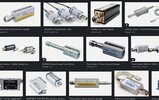The most basic system needs a dummy load to create the heat to be sensed.
That dummy load must have a low SWR (a good impedance match) over the frequency range of the sensor.
That is itself is not easy at GHz frequencies; eg. a precision load I had for around 10HGz some years back was a length of WG16 waveguide with a tapered wedge of lacquered wood in it!
It may not sound complex, but it had to have been assembled and tested / calibrated / the certificate and specification plate etc. for that particular unit all done individually by someone in the factory, using who knows how many tens of thousands of pounds worth of calibrated equipment for that frequency band, to be able to test and calibrate each dummy load unit, that they probably sold a few dozen of each year.
If it has been a power meter detector, it would also have had to be run and tested at multiple power levels, each run long enough to get a stable reading - and the whole thing re-worked if it was out of the permitted specifications at any point.
(Note that any particular size of waveguide only works over a certain range of frequencies, basically one octave, but such as load may have a more restricted range depending on its design).

en.wikipedia.org





